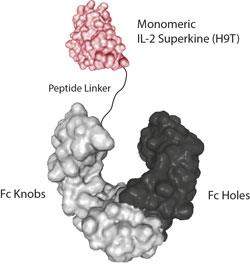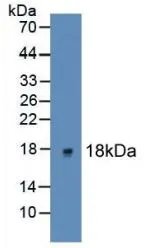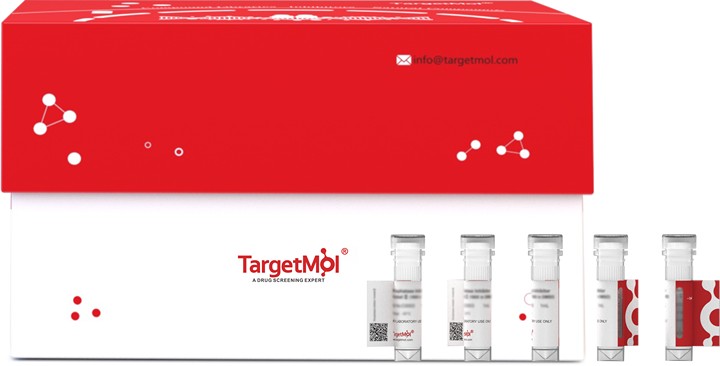
Protein Structure
IL-2 Superkine H9T (monomeric):Fc-KIH (human) (rec.)
AG-40B-0223
Protein IDP60568
Product group Proteins / Signaling Molecules
Overview
- SupplierAdipoGen Life Sciences
- Product NameIL-2 Superkine H9T (monomeric):Fc-KIH (human) (rec.)
- Delivery Days Customer7
- CertificationResearch Use Only
- Estimated Purity>95%
- Protein IDP60568
- Protein NameInterleukin-2
- Scientific DescriptionInterleukin-2 (IL-2) is a 133 amino acid glycoprotein with one intramolecular disulfide bond and variable glycosylation. It is secreted by activated T cells and induces proliferation and maturation of activated T cells, natural killer cells and lymphokine activated killer cells. IL-2 also stimulates proliferation of antibody-producing B cells, activates neutrophils and induces mononuclear cells to secrete IFN-gamma and TNF-alpha and -beta. Moreover, studies have shown that IL-2 is required for activation-induced apoptosis, an important homeostatic mechanism in the immune system, which is involved in the maintenance of peripheral tolerance to self-antigens. IL-2 promotes T cell proliferation and particularly naive T cells. IL-2 signaling on activated T cells is effected through a quaternary high-affinity receptor complex consisting of IL-2, IL-2Ralpha (CD25), IL-2Rbeta and IL-2Rgamma. Naive T cells are relatively insensitive to IL-2 as they only express small amounts of IL-2Rbeta and IL-2Rgamma. They only acquire sensitivity after CD25 expression, which captures the cytokine and presents it to the IL-2Rbeta and IL-2Rgamma receptors. IL-2 Superkine (Fc) is an artificial variant of IL-2 called H9, containing mutations at positions L80F / R81D / L85V / I 86V / I92F. These mutations are located in the molecules core that acts to stabilize the structure and to give it a receptor-binding conformation mimicking native IL-2 bound to CD25. These mutations effectively eliminate the functional requirement of IL-2 for CD25 expression and elicit proliferation of T cells. Compared to IL-2, the IL-2 superkine induces superior expansion of cytotoxic T cells, leading to improved anti-tumor responses in vivo, and elicits proportionally less toxicity by lowering the expansion of T-regulatory cells and reducing pulmonary oedema. A new version of IL-2 Superkine with a new additional mutation called H9T reduces the binding of IL-2Rgamma and promotes the expansion of CD8+ T cells without driving terminal differentiation. TCR-transgenic and chimeric antigen receptor-modified CD8+ T cells that are expanded with H9T showed stronger anti-tumor activity in vivo in mouse models of melanoma and acute lymphoblastic leukemia. The new variant of IL-2 called H9T, helps to maintain activated CD8+ T cells in a stem-cell-like state, with greater anti-tumor activity in two mouse models. Like IL-2 Superkine (H9), IL-2 Superkine (H9T) also works on human T cells. The protein IL-2 Superkine H9T (monomeric):Fc-KIH (human) (rec.) is produced by using two different vectors, one encoding for the IL-2 Superkine H9T:Fc Knobs sequence (synthesizing a protein of 45kDa) and one encoding for the Fc Holes sequence (synthesizing a protein of 28kDa). Both vectors transfected into HEK293 cells produce both Fc molecules (Knobs-into-Holes technology; J.B. Ridgway, et al.; Protein Eng. 9, 617 (1996)) required for dimerization and for secretion of the final protein IL-2 Superkine H9T (monomeric):Fc-KIH (human) (rec.). InVivoKines™ are a new generation of recombinant fusion proteins for immunotherapeutic, preclinical and translational in vivo research, developed and manufactured by AdipoGen Life Sciences. - InVivoKines™. Recombinant Protein. The extracellular domain of human IL-2 (aa 21-153) (mutant H9T containing the mutations of H9: L80F / R81D / L85V / I 86V / I92F and the new mutation Q126T) is fused at the C-terminus to the Fc portion of human IgG1 (Knobs-into-Holes technology) (see reference: J.B. Ridgway, et al.; Protein Eng. 9, 617 (1996)). Source: HEK 293 cells. Lyophilized. Contains PBS. Interleukin-2 (IL-2) is a 133 amino acid glycoprotein with one intramolecular disulfide bond and variable glycosylation. It is secreted by activated T cells and induces proliferation and maturation of activated T cells, natural killer cells and lymphokine activated killer cells. IL-2 also stimulates proliferation of antibody-producing B cells, activates neutrophils and induces mononuclear cells to secrete IFN-gamma and TNF-alpha and -beta. Moreover, studies have shown that IL-2 is required for activation-induced apoptosis, an important homeostatic mechanism in the immune system, which is involved in the maintenance of peripheral tolerance to self-antigens. IL-2 promotes T cell proliferation and particularly naive T cells. IL-2 signaling on activated T cells is effected through a quaternary high-affinity receptor complex consisting of IL-2, IL-2Ralpha (CD25), IL-2Rbeta and IL-2Rgamma. Naive T cells are relatively insensitive to IL-2 as they only express small amounts of IL-2Rbeta and IL-2Rgamma. They only acquire sensitivity after CD25 expression, which captures the cytokine and presents it to the IL-2Rbeta and IL-2Rgamma receptors. IL-2 Superkine (Fc) is an artificial variant of IL-2 called H9, containing mutations at positions L80F / R81D / L85V / I 86V / I92F. These mutations are located in the molecules core that acts to stabilize the structure and to give it a receptor-binding conformation mimicking native IL-2 bound to CD25. These mutations effectively eliminate the functional requirement of IL-2 for CD25 expression and elicit proliferation of T cells. Compared to IL-2, the IL-2 superkine induces superior expansion of cytotoxic T cells, leading to improved anti-tumor responses in vivo, and elicits proportionally less toxicity by lowering the expansion of T-regulatory cells and reducing pulmonary oedema. A new version of IL-2 Superkine with a new additional mutation called H9T reduces the binding of IL-2Rgamma and promotes the expansion of CD8+ T cells without driving terminal differentiation. TCR-transgenic and chimeric antigen receptor-modified CD8+ T cells that are expanded with H9T showed stronger anti-tumor activity in vivo in mouse models of melanoma and acute lymphoblastic leukemia. The new variant of IL-2 called H9T, helps to maintain activated CD8+ T cells in a stem-cell-like state, with greater anti-tumor activity in two mouse models. Like IL-2 Superkine (H9), IL-2 Superkine (H9T) also works on human T cells. The protein IL-2 Superkine H9T (monomeric):Fc-KIH (human) (rec.) is produced by using two different vectors, one encoding for the IL-2 Superkine H9T:Fc Knobs sequence (synthesizing a protein of 45kDa) and one encoding for the Fc Holes sequence (synthesizing a protein of 28kDa). Both vectors transfected into HEK293 cells produce both Fc molecules (Knobs-into-Holes technology; J.B. Ridgway, et al.; Protein Eng. 9, 617 (1996)) required for dimerization and for secretion of the final protein IL-2 Superkine H9T (monomeric):Fc-KIH (human) (rec.).
- Storage Instruction-20°C,2°C to 8°C
- UNSPSC12352202




